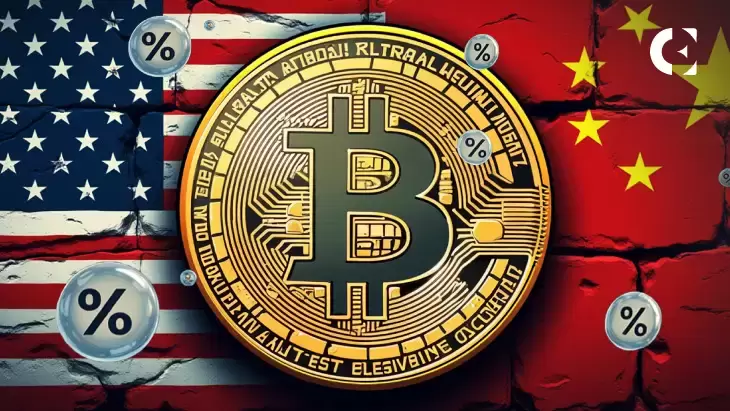 |
|
 |
|
 |
|
 |
|
 |
|
 |
|
 |
|
 |
|
 |
|
 |
|
 |
|
 |
|
 |
|
 |
|
 |
|
Cryptocurrency News Articles
Bitcoin Halving: A Seismic Event Reshaping the Crypto Landscape
Mar 31, 2024 at 01:03 am
Bitcoin halving, scheduled for April 2024, will reduce block rewards for miners by half, impacting market dynamics, mining profitability, and consumer behavior. This event has historically triggered market anticipation and speculative trading, with potential price surges. Large mining operations are adjusting their capacities to maximize rewards, while smaller miners face competitive pressures. Bitcoin holders and users may experience price volatility and uncertainty in transactions. The halving serves as a balancing act, regulating supply and incentivizing miners, influencing the long-term stability and viability of the Bitcoin network.

Bitcoin Halving: A Seismic Event in the Crypto Landscape
In the ever-evolving realm of cryptocurrencies, Bitcoin halving stands as a pivotal event, poised to reshape the landscape for traders, investors, and the broader crypto community. As the next halving approaches in April 2024, it's imperative to delve into its profound implications.
The Intricacies of Bitcoin Mining
Before unraveling the significance of halving, it's crucial to understand the intricate workings of Bitcoin mining. Imagine a virtual gold rush, where miners, armed with powerful computers, relentlessly compete for the chance to earn newly minted Bitcoins. Transactions, like sending or receiving Bitcoins, flow into a pool of instructions, awaiting validation. Miners, acting as digital bookkeepers, gather these transactions and consolidate them into blocks.
Each block undergoes a unique hashing process, a complex mathematical algorithm that scrambles its data, including transactions, into a unique digital fingerprint called a hash. Miners engage in a relentless trial-and-error process, infinitesimally modifying the block's data to generate a hash that falls within a specific difficulty range. It's akin to cracking a high-security code, where the more challenging the setting, the more arduous the search for the correct combination.
This difficulty setting isn't static but dynamically adjusts to maintain a steady flow of new blocks added to the blockchain, a digital ledger that records all cryptocurrency transactions. If too many miners join the fray, easing the difficulty of finding valid hashes, the challenge escalates. This ensures a level playing field and prevents the hasty addition of new blocks.
Defining Bitcoin Halving: A Controlled Reduction in Mining Rewards
Bitcoin halving is a meticulously programmed event in the Bitcoin protocol that slashes the reward for mining new blocks by half. This occurs roughly every four years and has a profound impact on the Bitcoin ecosystem. The initial block reward of 50 BTC has steadily diminished to 25 BTC in 2012, 12.5 BTC in 2016, and 6.25 BTC in 2020. April 2024 marks the next significant milestone, reducing the reward to a mere 3.125 BTC.
Unveiling the Significance of Bitcoin Halving
The importance of Bitcoin halving lies in its ability to strike a delicate balance between maintaining the supply of new Bitcoins and incentivizing miners to maintain the network. With approximately 19.65 million Bitcoins already in circulation, halving plays a pivotal role in curbing inflation and ensuring the longevity of the network.
Inflation Control: A Deflationary Mechanism
Halving directly addresses inflation concerns. Unlike fiat currencies, where central banks can influence inflation rates, Bitcoin's halving mechanism automates this process. By reducing the rate of new coins entering the market, it creates a deflationary pressure, thus bolstering the value of existing Bitcoins.
Investment Dynamics: A Double-Edged Sword
For investors, halving presents a double-edged sword. On one hand, it promises potential appreciation in Bitcoin's value due to decreased supply. However, it also enters speculative territory, rendering Bitcoin's future price movements unpredictable and subject to market forces.
Mining Ecosystem: Challenges and Consolidation
Mining, the backbone of the Bitcoin network, faces significant repercussions from halving. Post-halving, miners receive fewer rewards, potentially undermining the profitability of mining, especially if Bitcoin's market price doesn't compensate for the diminished rewards. This could lead to a consolidation in the mining industry, with smaller players struggling to compete against larger, more efficient miners.
Market Anticipation: A Surge of Speculation
Historically, each halving event has ushered in increased market attention and speculative trading, often leading to price surges. However, past performance is not a definitive predictor of future outcomes, and the 2024 halving will be no exception. Traders and investors must approach cautiously, balancing optimism with a pragmatic assessment of market conditions.
Mining Adjustments: A Race for Efficiency
Large mining operations, like Marathon Digital Holdings, are ramping up their capacities in anticipation of the halving. This surge in capacity not only increases their chances of securing block rewards but also reflects the competitive nature of the mining industry as it prepares for reduced rewards.
Consumer Impact: Volatility and Price Adjustments
For everyday Bitcoin owners, the halving presents a mixed bag. Price volatility could affect the value of their holdings and transactions. Those using Bitcoin for remittances or purchases might find the post-halving period particularly unpredictable, as the market adjusts to the new supply rate.
The Enduring Legacy: A Testament to Bitcoin's Ingenuity
Bitcoin halving is more than a technical adjustment; it's a fundamental event that shapes the cryptocurrency's future. It influences everything from market dynamics to the viability of mining operations. As the April event approaches, all eyes are on Bitcoin, not just as a currency or investment, but as an indicator of the evolving digital economy. The forthcoming halving is not just a momentous occasion but a testament to the ingenious design of the Bitcoin protocol, poised to continue its legacy in the realm of digital currencies.
Disclaimer:info@kdj.com
The information provided is not trading advice. kdj.com does not assume any responsibility for any investments made based on the information provided in this article. Cryptocurrencies are highly volatile and it is highly recommended that you invest with caution after thorough research!
If you believe that the content used on this website infringes your copyright, please contact us immediately (info@kdj.com) and we will delete it promptly.
-

-

-

- The Crypto Market's Been Cooking Up Fresh Narratives This Year—from Bitcoin Crossing All-Time Highs to Solana's Gasless Memecoin Mania
- Apr 12, 2025 at 12:30 pm
- The crypto market's been cooking up fresh narratives this year—from Bitcoin crossing all-time highs to Solana's gasless memecoin mania. But here's what's flying under the radar
-

-

- Today, the broader cryptocurrency market experienced a significant sell-off, erasing $314.69 million in liquidations.
- Apr 12, 2025 at 12:25 pm
- Today, the broader cryptocurrency market experienced a significant sell-off, erasing $314.69 million in liquidations. According to metrics shared by Phoenix Group, a total of 108138 traders were liquidated
-

-

-

-




















![Crypto Otaku - CRYPTO CHAOS! 83K BITCOIN! CRYPTO RALLY!! XCN , JASMY , SWFTC LEAD!!! [Episode 228] Crypto Otaku - CRYPTO CHAOS! 83K BITCOIN! CRYPTO RALLY!! XCN , JASMY , SWFTC LEAD!!! [Episode 228]](/uploads/2025/04/12/cryptocurrencies-news/videos/crypto-otaku-crypto-chaos-k-bitcoin-crypto-rally-xcn-jasmy-swftc-lead-episode/image-1.webp)









































